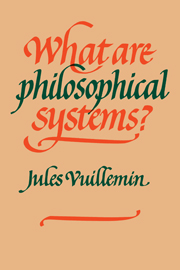4 - A CLASSIFICATION OF PHILOSOPHICAL SYSTEMS
Published online by Cambridge University Press: 04 August 2010
Summary
There are many ways of subjecting myth to the axiomatic method and of answering the questions which determine a philosophy as a presumably consistent and systematic ontology. How are reality and appearance divided? What principles and what specific kind of demonstration are recognized as true and valid?
When the writings of a philosopher – or possibly some of his particular works – are analysed in order to make explicit the principles and methods of proof according to which he draws the boundary between reality and appearance, the historian is naturally led to comparisons. By reconstructing in their individuality some of the systems which constitute the object of his discipline, he meets open discord as well as seeming agreements with other systems, and is obliged to trace their cause to differences regarding a given premise or a given set of premises. Partial, occasional and a posteriori classifications result from such comparisons.
We have met some cases of reductiones ad absurdum that seemed to delineate an a priori framework for the possible solutions which philosophical systems could give to a particular question. Nothing, however, hinted at a possible generalization. Moreover, the formal convergences which are suggested when a contradiction is analysed away threaten to conceal or to prejudge the genuine philosophical issues.
We shall first ask whether a general and truly a priori classification of philosophical systems is possible and on just what conditions that would be.
- Type
- Chapter
- Information
- What Are Philosophical Systems? , pp. 115 - 134Publisher: Cambridge University PressPrint publication year: 1986



